
Water entering our apartments through drain pipes cannot be considered perfect. It contains many impurities that negatively affect the operation of the washing machine. Calcium and magnesium are particularly dangerous for heating elements. These substances form compounds that are deposited on the heating elements and over time can lead to their failure.
The content of the article
- How to clean the washing machine with Lemonic acid from the scale?
- How to clean the washing machine with vinegar?
- How and how to clean the washing machine from mold?
- How and how to clean the washing machine from the smell of a swamp?
- How to clean the washing machine with soda?
- How to clean the washing machine with white?
- How and how to clean the elastic band in a washing machine?
- How and how to clean the drain hose in the washing machine?
- How to clean the drain filter in a washing machine?
- How to clean the washing machine with an AMVei bleach?
- Tips and reviews
- Video. How to clean the washing machine from the scale (very effective)?
But, in addition to “hard” water, the mobile elements of washing powders also have a detrimental effect. The deposits formed by water and cleaning means of deposit can reduce the service life of the “automatic” by 2-3 times. And since buying a new one is quite expensive, in order not to lose your money, it is necessary to periodically clean it from scale.
Important: in addition to the risk of failure of the heating element, scale can increase energy consumption. Covered by the deposits of the heater heating water longer, which means your household appliance will consume more electricity.
How to clean the washing machine with Lemonic acid from the scale?
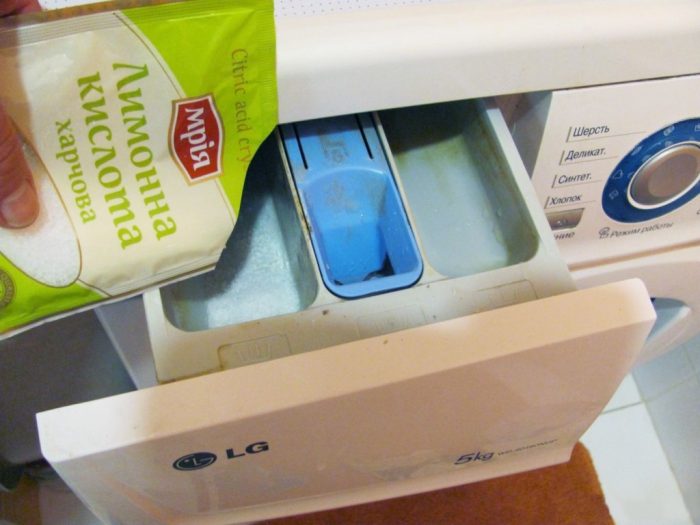
"Limonka" has long been successfully used for cleaning dummies and irons from solid deposits
You can use it for removing the scale in the washer. This is a very cheap, but at the same time, a working method of cleaning the heater.
A means in those quantities in which is used is absolutely harmless. After the cleaning procedure, it is easily washed out. Which, by the way, does not always happen to special means that are used to remove deposits. They often remain on clothes.
This substance refers to the class of carboxylic acids. Acids of this class react with metals and deposits and destroy their connections. In expensive means from scale, carbon acids are most often present. But at the same time, such professional tools cost an order of magnitude more expensive.
If your "automatic" contains 4 kg of linen, then 3 tablespoons of the product will be enough to clean it. It is covered in a powder tray and turned on with rinsing and spinning.
This universal substance can be used not only for cleaning, but also for the prevention of deposits on heating surfaces. To do this, choose a delicate washing mode at 60 °. But, if you have not used such a cleaning for a long time and suspect that there is quite a lot of scale on Ten, then it is better to turn on the wash at high temperatures.
In order to extend the service life of the heating element, clean it from scale using citric acid at least once every four months. At the same time, you do not need to do anything. Pour the product, turn on the wash in the right mode and wait until the “automatic” cleans the heating device from dirt and scale and salt the water into the sewer.
Important: when using citric acid, it is important to observe precautions. Do not fall asleep this substance more than the necessary. This can negatively affect the rubber and plastic parts and elements of the mechanism. In addition, do not turn on the washing mode with a temperature of more than 90 degrees.
How to clean the washing machine with vinegar?
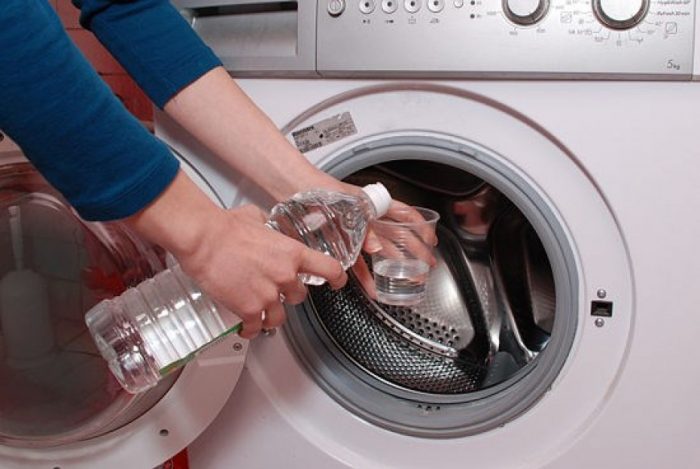
Acetic acid is another effective tool for cleaning heating surfaces from solid deposits
Using vinegar, you can not only clean such elements from scale, but also clean the inside of the “machine gun” from mold.
Vinegar, which is in every kitchen, will prevent mold in the hard -to -reach places of your washing machine. Where mechanical cleaning is impossible. In addition, acetic acid can cope with a musty smell, which is sometimes transmitted by linen.
The vinegar, as a means of scale, has only one minus - a pungent smell. You can cope with it using an additional rinse procedure. And when using this window, it is better to open the window or periodically ventilate the room.
Important: when using vinegar to clean the "automatic", dosage must be observed. Do not exceed the amount of this tool in order to clean "for sure." This can lead to the fact that the vinegar is corroded with rubber gaskets and plastic elements of the mechanism.
To clean the heating device, you will need 2 cups of white vinegar. It, as well as citric acid, must be poured into the compartment for washing powder and turn on the washing. The optimal temperature regime is 95 °.
After the water warms up to the specified temperature, you need to turn it on to the pause and stop the wash for 50-60 minutes. Then we renew the wash again and wait until the washing machine fulfills all the necessary requirements.
After such cleaning, it is important to check the drain filter for the presence of residues from the scale. Then we start the laundry washing mode again. It is not necessary to fill vinegar into the tray for powder.
Important: it is impossible to combine vinegar with other means from scale. This can lead to a quick breakdown of parts.
With the help of vinegar, you can clean the drum and a tray of the washing machine from pollution. To do this, moisten a napkin in vinegar and wiped contaminated surfaces.
How and how to clean the washing machine from mold?
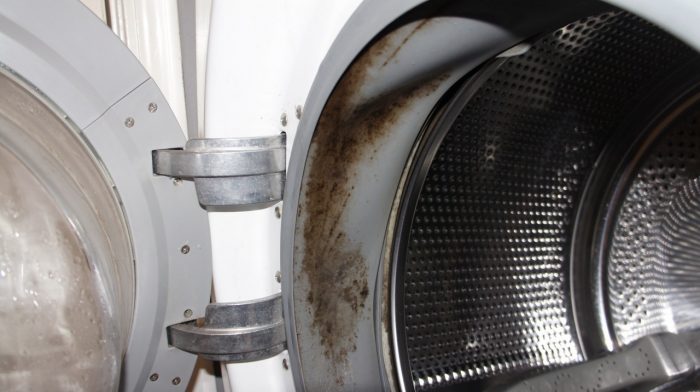
The presence of mold in the "automatic" may indicate a musty smell from the drum
You need to deal with mold immediately after the discovery of its signs. After all, she can not only stain clothes, but also negatively affect human health. The spores of the fungus can adversely affect health. For example, a known disease, bronchitis is caused by mold spores that fell into the lungs during breathing.
Mold can appear in a washing machine if it is washed in it at low temperatures. At temperatures above 90 ° C, the fungus is destroyed. But, if you rarely wash and at low temperatures, then the risk of mold is great. The ideal environment of the fungus is damp.
The sooner the fungus is discovered, the more chances to get rid of it. Check visually the powder tray, an elastic band around the door, a drain hose, a filter and a hose along which water comes from the water supply.
First, mold clusters must be treated with a hard brush using detergents. Then, you need to go once again with a special tool for mold. Expensive preparations for fungi can successfully replace ordinary soda. It is mixed with a small amount of water and the place pre -treated with the detergent of the place is cleaned.
In order to clean the inner surfaces from mold, it is necessary to pour into the bar for powder vinegar. You can use soda. Enough 400 grams of this substance.
After that, you need to select the washing mode with the longest time and the highest temperature. After the water temperature is heated to the selected, you need to stop the wash and put the washing machine for a pause for 2 hours.
Then it is necessary to turn on the wash again and wait for its end. Thanks to these actions, the drum, heating element, drain pump and tank can be cleaned of mold. At the end of cleaning the washing machine from mold, you need to wipe all possible places dry.
Important: you should not to enhance the effect in the tray for powder immediately and chlorine and vinegar. Of course, such a mixture will perfectly cope with the fungus, but can damage the internal details of the washing machine.
If the described methods do not help to cope with mold, then most likely you will have to disassemble the washing machine and clean the insides manually. Here you can not do without professional help.
To prevent this problem, it is necessary to wipe the tray for powder, rubber seal and other elements after each washing.
Use only the required number of linen rinsers. They are poorly washed out and can become an excellent habitat for mold fungus. It can also provoke the appearance of mold pure linen, “forgotten” in the washing machine.
To prevent this problem, wash with the bleach once a month at maximum temperature. And do not forget about the hoses and the drain filter. The mold appears very often in them.
How and how to clean the washing machine from the smell of a swamp?
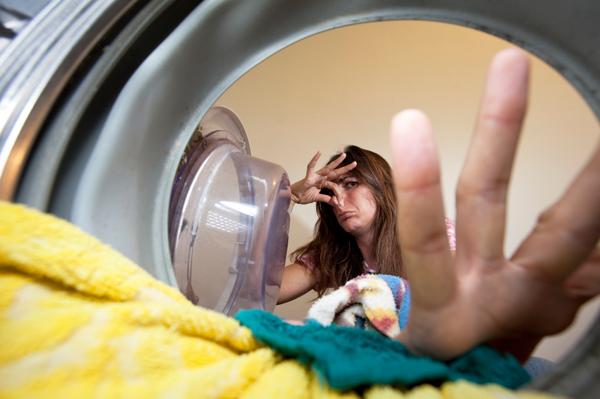
As in the case of mold, the cause of a musty smell is a fungus
Usually the smell of the swamp appears in old washing machines that were not properly used. But, even if you did everything right, the risk of smell of rot is still present. It can appear for the following reasons:
- Immediately after washing, the hatch closes. Since a little water remains in the drum and ventilation is missing the habitat of the fungus that causes a sharp and unpleasant smell
- The use of poor -quality powder. If the powder is poorly dissolved in water, its clots can stick to the walls, stay in the hoses and the supply channel to the drum. Over time, the same fungus can form in them. The fungus can also settle in the remains of powder in the tray for the detergent
- If the washing machine is incorrect to the sewage system, its smell can penetrate the hose inside the drum. Connect this device with a mandatory hydraulic planter
If you felt an unpleasant odor in your washing machine, then first of all you need to understand its cause. Check its connection, drainage hose and filter. Clean and rinse all possible details. Pay special attention to the tray for the powder.
Very often, a fungus that causes the smell of a rotten swamp to “settle” in the channel, through which detergents get from the tray into the drum. You can rinse this channel in the same way as when washing the washing machine from mold. Just pour vinegar or whiteness into the powder tray or turn on the washing at high temperature.
The above method perfectly helps not only to clear the “automatic” of mold and lime deposits, but also from a fungus causing a musty smell. Therefore, such a procedure with preventive purposes must be carried out once a month.
If, nevertheless, it was not possible to get rid of the smell of rot, then you need to use more radical means. It is necessary to pour 300 ml of tools for cleaning the sewage system into the powder tray and wash. Then it is necessary to put on a rinse.
If the drainage hose is the cause of the putrefactive odor, then its cleaning will not help. It is better to immediately replace this hose with a new one. And do not forget about prevention measures. This will help to avoid mold problems, screaming and an unpleasant odor.
How to clean the washing machine with soda?
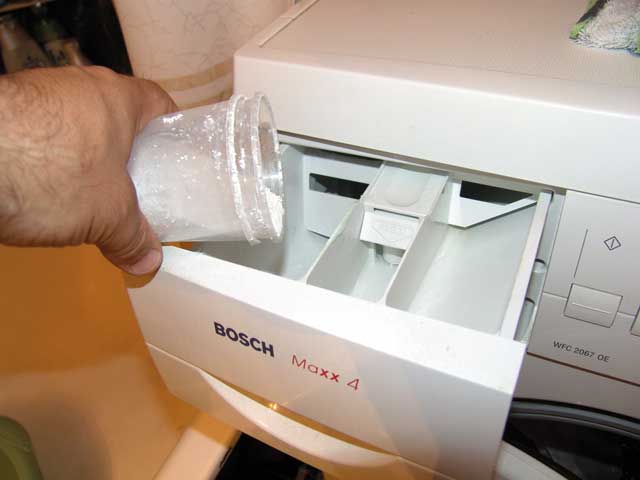
Soda is very often used in everyday life
This tool can be called universal. She is cleaned with kitchen utensils, used to remove stains and used in cooking. It can also be used to clean the washing machine.
By nature, Soda is an alkali. Three types of soda are used in everyday life: food (Nahco3), calcified (Na2CO3) and caustic (NaOH). The baking soda is the weakest in its alkaline effect. And the strongest, caustic, in everyday life is practically not used.
Soda can be used to clean domestic devices from deposits and mold. To clean all available surfaces, a solution is made. To do this, mix soda and water in equal proportions and the resulting paste is applied with a sponge to the drum, elastic band and other parts. The product is left in this form for 30 minutes, and then thoroughly washed off with water and activated the “rinsing” mode.
Important: In order not to damage the skin on the hands with such work, you need to apply soda on the surface in protective gloves.
The same can be done with the separation for powder. The soda solution is applied to its walls for 15-20 minutes, and then washed off.
You can buy such soda in the sections of household chemicals of large supermarkets.
How to clean the washing machine with white?
Using a solution of chlorine, you can easily cope with pollution inside the drum, mold and fungus, causing an unpleasant odor. To do this, the product must be poured directly into the drum and turn on the washing with a temperature of 90 ° C. When the water warms up, it is necessary to stop the washing for 1 hour. Then you need to resume the work and wait until the "automatic" will rinse.
Of course, with such cleaning, no things can be loaded into the drum.
How and how to clean the elastic band in a washing machine?
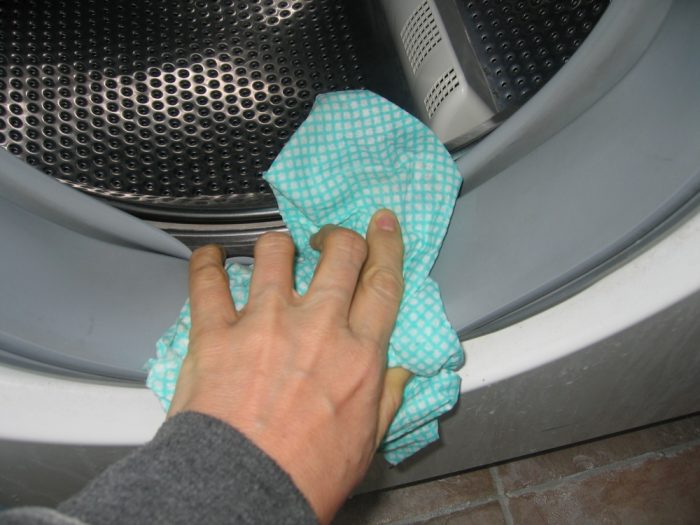
Sealing gum, which is located around the drum window, is called the cuff
It protects against leaks, but at the same time often becomes a habitat of mold. The fungus is formed on the cuff due to moisture residues. Therefore, in order not to wash the mold from the rubber sealing gum, after each wash, wipe it dry.
If the cuff has already been covered with mold and water divorces, then they need to be removed using chlorine -based products (“white”, “toilet duckling”, “domestos”, etc.), copper sulfate or varnish to relieve varnish. Also, to clean the surfaces from divorces, you can use vinegar or antinagipine.
The cuff must be wiped from all possible sides. Particular attention must be paid to the grooves of the elastic band. They may accumulate pollution, which cause an unpleasant odor and mold. You can even pour a little detergent into the grooves of the sealing gum and leave it there. Then it must be thoroughly washed and wipe the elastic band.
If a solution of copper sulfate is used for cleaning the seal, then it is diluted in the proportions of 30 g per liter of water.
How and how to clean the drain hose in the washing machine?
One of the "weak" places of the machine is a drain hose. Thanks to the drain filter, he cannot clog. But, it may remain deposits that will negatively affect the smell of linen. In addition, such deposits are a good habitat of the fungus causing mold.
Unfortunately, in various detergents, the drain hose is joined in different ways. Therefore, in order to disconnect it, you need to know the nuances. But, before doing this, be sure to turn off the “automatic” from the network and close the water supply crane. Then you need to drain the remaining water through the filter and disconnect the end of the hose, which is inserted into the sewer pipe.
The second end, as already mentioned above, joins the washing machine differently. Samsung, Indesit, LG, Beko, Ariston, WhirPool, Candy and others will first have to remove the lower panel. And in some models Zanussi and Electrolux back cover. In the washing machines of German brands Bosch, AEG and Siemens in order to remove the drain hose you need to open the front panel. In most cases, you will have to use a screwdriver. And the hose itself is attached to the clamps.
When you manage to remove the hose, you need to check it for defects and clean it with a special cable. At the same time, the cable should not be metal, which scratches the inside of the hose and leads to the fact that dirt will accumulate in them. It is best to buy a Kevlar cable with a ruff at the end. Such cables are sold in special economic stores.
The cable must be inserted into the hose and used as when cleaning dishes with a narrow neck. First you need to "go" in one direction, and then in the other.
After such cleaning, the hose must be put in place. To enhance the effect, you can start a washing machine using citric acid instead of powder. With its help, you can not only clean the hose, but also remove the scale from the heating heating element.
If the cleaning of the hose is quite troublesome for you, then replace it with a new one. Such a hose is not very expensive.
How to clean the drain filter in a washing machine?
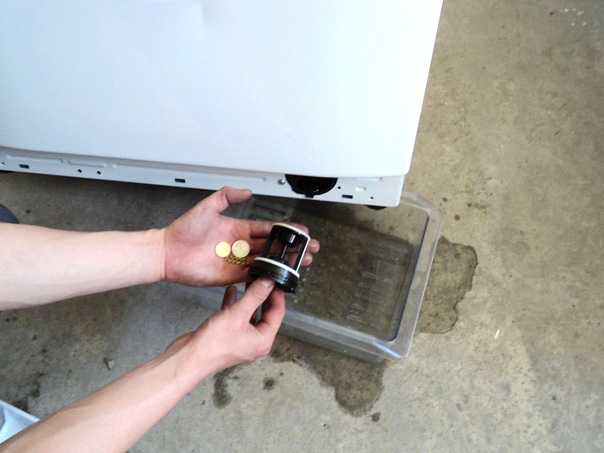
Two filters are used in the automatic machine
One is installed on clean water and protects against large particles that may be present in water pipes. And the second is placed on the plum. And unlike the input filter, this must be regularly cleaned so that the washing machine is functioning correctly and an unpleasant odor and mold does not appear in it.
The drain filter is located in a washing machine under a special lover cover. It should be attached to the latches and in order to remove the problems it should not arise. If such a hatch is not visible on your model, then most likely you will have to look for a drain filter under the back panel. You can find out where the drain filter is from the instructions for your modeling machine.
The drain filter in its design resembles a cork that is twisted on a special hole. Such a cork is unscrewed counterclockwise. In old models, the filter can be attached on the bolt.
In order for the remnants of water not to be filled on the floor before unscrewing the filter, you need to substitute low dishes. After the water merges (it will not be very much), it is necessary to get the remaining garbage and dirt from the hole and rinse it.
Then you need to clean the filter itself. To do this, it must be washed in clean water and remove all the dirt out of it. Then it is necessary to tighten the filter in its place. The filter after twisting should sit tight and not hang out.
How to clean the washing machine with an AMVei bleach?
AMVEI company produces an oxygen bleach that does not contain chlorine. He will cope well with stains on a rubber seal, a drop in a heating device, mold and remains of detergents. The product can be applied to the sponge and wipe the surface with it. And you can pour into the powder compartment (100 ml) and turn on the washing at 60 ° C.
Washing the washing machine and cleaning it from scale is quite simple and at the same time not very costly. But, it is best to periodically carry out preventive cleaning. Then you can be sure that the musty smell, mold and habitat will not spoil your “automatic”.
Tips and reviews
Kate. I always use a lemon to clean all devices where scale can form. 100-120 gr. I fall asleep into the tray and turn on the wash. I do this 2-3 months. Ten is like new.
Lisa. In my kettle, the scale is constantly forming. I suspect that on the heating device of the automatic, the same thing. Prevention must be carried out. I'll try vinegar. I hope it will help.
